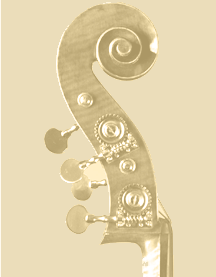Orin O'Brien's Double Bass NotebookThere
is a new double bass book out now by Orin O'Brien, a well
known player and bass teacher. She currently plays in the New York Philharmonic and has
been a member there since 1966. She teaches at both Julliard and
the Manhattan School of Music and has had many, many great
students. One of them she even mentions in her book, Michael
Kazepides,
whom I have have the pleasure of working with in the Phoenix
Symphony. Mike sometimes tells me about something he learned or
studied from Orin and to my delight, some of that magic is here in
her new book, "Double
Bass Notebook".
teacher. She currently plays in the New York Philharmonic and has
been a member there since 1966. She teaches at both Julliard and
the Manhattan School of Music and has had many, many great
students. One of them she even mentions in her book, Michael
Kazepides,
whom I have have the pleasure of working with in the Phoenix
Symphony. Mike sometimes tells me about something he learned or
studied from Orin and to my delight, some of that magic is here in
her new book, "Double
Bass Notebook".
This is not your ordinary Storch-Hrabe or Simandl bass book.
Don't forget that at her level of playing and the level of students
she's had, she doesn't waste any time getting down to business.
She first explains how this notebook came about and honors the
bassists and teachers that taught her or were a big part of her
life. The book consists of 114 pages of photos, musical
examples and her personal instructions on how she likes to play
them.
On page 4, she jumps right into outlining body position with the
bass, arm weights, relaxation and some great anecdotes to help
players image and visualize playing points. She gives daily
practice schedule ideas for morning or afternoon!, then for
afternoon or evening. Even 4 year plans that list study books, and
solos that people should be on during their 4 year plan or schedule.
Very intense already Orin!
 If
you are a serious classical bass player and aspire to be the
best (and aspire to get a symphony job), you should have this book!
Even if you already have some totally awesome teacher, this book
would be a great addition in conjunction to your studies. If
you are a serious classical bass player and aspire to be the
best (and aspire to get a symphony job), you should have this book!
Even if you already have some totally awesome teacher, this book
would be a great addition in conjunction to your studies.
On page 64, under "Phrasing" she wrote:
"Try to determine whether the line you are playing is
melody or accompaniment. If the line is melody, listen to the
first phrasing of the same melody and try to copy it. If it is
accompaniment, it should be rhythmic, precise, and slightly
subsidiary (for example: the do-sol figures in Rossini.) If
the line consists of harmony changes (Brahms symphonies have many of
these beautiful lines), sometimes a slight emphasis is needed, often
produced by simply making a clear bow-change. This can often
help a conductor, when he is busy with other elements in the
orchestra. If you know the score you will know what parts you
should emphasize and what parts you should know are subsidiary and
need to be subdued."
Here's a brief list of some of the major points that she
covers in the book:
- Daily Practice schedules
- Four Year Plan (don't forget...she teachers in college!)
- Recommended Study Material for Reading and Listening
- Daily Warm-Up Finger Exercises (this one alone, worth the
whole price of the book!)
- She explains how to actually use the Zimmermann bowing book
(I always thought it a "boring" book, but nice to have someone
show how to use this book...by the way, Zimmermann was her
teacher.
- Shifting
- Scale and Arpeggio "Suggestions"
- Hooked bowings
- Rotation System of Practice (another good one for me.)
- Basic Principals of Orchestra playing
- Then she gets into Orchestra Bass auditions, how to prepare,
what is asked for etc...
- I personally liked reading the chapter on "Professional
Behavior and Auditions" (I am bad at turning and looking...)
Order here or see other books on the link below:
More upright double bass books here
|


